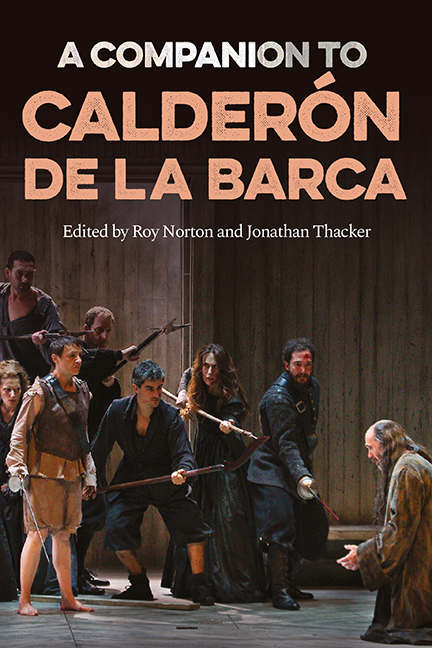Book contents
- Frontmatter
- Dedication
- Contents
- List of Illustrations
- List of Contributors
- Acknowledgements
- List of Abbreviations
- Introduction
- 1 Biography and Context
- 2 The Calderonian World
- 3 The Playwright’s Craft: Calderón and the Great Theatrical World of Early Modern Spain
- 4 La vida es sueño
- 5 The Honour Plays of Calderón
- 6 Calderón, the Comedian
- 7 Mythological Court Spectacle Plays
- 8 Religious comedias
- 9 Calderón’s ‘Sacramental, Allegorical and Historical’ autos
- 10 Calderón’s graciosos
- 11 Calderón and Visual Art
- 12 The Staging of Calderón’s Theatre
- 13 Calderón’s European Reception from Romanticism to the Twentieth Century
- 14 The Reception of Calderón in the Hispanic World
- Appendices
- Consolidated Bibliography
- Index
- Tamesis • Companions
1 - Biography and Context
Published online by Cambridge University Press: 07 October 2022
- Frontmatter
- Dedication
- Contents
- List of Illustrations
- List of Contributors
- Acknowledgements
- List of Abbreviations
- Introduction
- 1 Biography and Context
- 2 The Calderonian World
- 3 The Playwright’s Craft: Calderón and the Great Theatrical World of Early Modern Spain
- 4 La vida es sueño
- 5 The Honour Plays of Calderón
- 6 Calderón, the Comedian
- 7 Mythological Court Spectacle Plays
- 8 Religious comedias
- 9 Calderón’s ‘Sacramental, Allegorical and Historical’ autos
- 10 Calderón’s graciosos
- 11 Calderón and Visual Art
- 12 The Staging of Calderón’s Theatre
- 13 Calderón’s European Reception from Romanticism to the Twentieth Century
- 14 The Reception of Calderón in the Hispanic World
- Appendices
- Consolidated Bibliography
- Index
- Tamesis • Companions
Summary
Before Philip II's return to Spain from Flanders in 1559, the Spanish court had no fixed administrative centre. Philip first chose Valladolid as his capital, but in late 1559 he moved to Toledo. In May 1561 he changed his mind again, and opted for Madrid. Madrid's population was perhaps only 9,000, but it had a royal palace (the alcázar), refurbished by Philip and his father in the 1540s. There were no printing-houses until 1566, and no cathedral until 1885, but there were ancient churches with venerable images; there was no university, but the renowned University of Alcalá was only twenty miles away; and there was plenty of land for building. As Madrid became the nation's cultural capital, those hoping to make a career in literature or the arts were drawn there; and as the comedia nueva [new play] was created and became one of the richest dramatic traditions the world had yet seen, the presence of the court encouraged its development. If Lope de Vega was one of the main creators of the comedia nueva, the chief exponent of court drama was Calderón.
The court's arrival almost doubled the town's size to 16,000; by Philip's death (1598), the population was around 80,000; within twenty years it had doubled again. This rapid growth was achieved by immigration, mostly from other parts of the peninsula; the growth in construction tried to keep up, but many newcomers lived in hastily assembled tenements and shacks on the outskirts. Several locations were converted into playhouses before 1600, and two of these, the Corral del Príncipe and the Corral de la Cruz, proved enduring. Originally rectangular corrales [yards], surrounded by tenements, they had a raised stage at one end of the yard, with the rest devoted to spectators, as were balconies around three sides; the balcony above the stage was another performance area. By 1623, a large hall (the salón de palacio) in the alcázar had been turned into a theatre, with a stage at one end; finally, the new Retiro Palace came to include Madrid's first purpose-built theatre, the Coliseo (1640), with artificial lighting and movable perspective scenery; this was a royal theatre, but the paying public was admitted.
- Type
- Chapter
- Information
- A Companion to Calderón de la Barca , pp. 15 - 32Publisher: Boydell & BrewerPrint publication year: 2021



